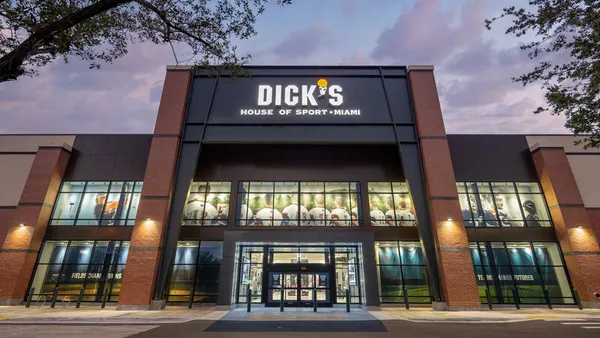Dive Brief:
-
Ross Stores on Tuesday reported fourth quarter total sales grew 16% year over year to $4.1 billion. During the quarter same-store sales rose 5%, on top of a 4% increase in the prior year, with sales trends "fairly broad-based" across all major categories but with children's performing best. The results beat the Wall Street estimate cited by Cowen & Co. for a 3.1% rise and Ross's own guidance for the quarter of between 2% and 3%, and the top-line figure handily beat FactSet's estimate cited by Marketwatch for sales of $3.96 billion.
-
The retailer's operating margin in the quarter grew 95 basis points to 14.6%, up from 13.6% in the prior year, driven by a combination of strong merchandise margin, expense leverage from solid gains in same-store sales and the impact of an extra 53rd week. For the 2017 fiscal year, operating margin increased 50 basis points to a record 14.5%, executives told analysts on a conference call Tuesday.
-
But shares fell late in the day because of the off-price retailer's muted guidance for 2018 same-store sales of 1% to 2%, compared to 4% gains in each of the past three years, and well below the FactSet analyst estimate cited by Marketwatch for 3.5%. (It's worth noting that, as analysts have pointed out, Ross has a history of underselling on its guidance.)
Dive Insight:
Despite the share price tumble, Ross's position as an off-price retailer bodes well, no matter the state of the economy, Ross President and Chief Operating Officer Michael O'Sullivan told analysts, according to a transcript from Seeking Alpha.
"[I]f we look back historically at our performance, we've done well as a business when the economy is doing poorly and we've done well in the business when the economy is doing well," he said. That is, in better times, the value proposition at off-price retailers stands out as department stores ditch promotions, and in worse times supply improves as department stores fail to move merchandise, he explained.
Analysts led by Oliver Chen at Cowen & Co. see it that way, too. "[W]e are encouraged that [Ross'] business model is flexible and has proven to work in periods when the economy is both good or bad," Chen said in a note emailed to Retail Dive. "[C]ontinued customer interest in value, compelling inventory availability and consistently improving home and ladies apparel categories should be able to drive comps at least towards the high end of the guided range, in our view."
Of course, a better economy lifts all boats, and executives noted that wage pressures and tight freight capacity, which are adding to its expenses, are nevertheless signs of a healthy economy.
The retailer may also be finding better merchandise thanks to e-commerce growth, which has also spurred a higher rate of returns. "[T]hat could be, I underline the word 'could,' one of the additional things that's contributing to the abundant availability that we are seeing," O'Sullivan said.
The company also plans to add about 100 new stores this year — 75 Ross and 25 dd's DISCOUNTS locations — and to close or relocate about 10 older stores. New store productivity has been somewhat consistent around 60% to 65% for Ross, according to CFO Michael Hartshorn.














